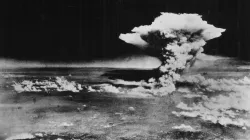Nobel Peace Prize 2024: Why Japan nuclear bombs survivors chosen for eminent award | 10 POINTS
The Nobel Peace Prize was awarded to Nihon Hidankyo, a Japanese organisation of survivors of the US atomic bombings of Hiroshima and Nagasaki, for its activism against nuclear weapons.

Stockholm: Japanese organisation Nihon Hidankyo, a grassroots movement of atomic bomb survivors from Hiroshima and Nagasaki, won the Nobel Peace Prize on Friday, in a warning to countries who have nuclear weapons not to use them. Witnesses to the only two nuclear bombs ever to be used in conflict, members of the group, also known as Hibakusha, have dedicated their lives to the struggle for a nuclear-free world.
"Hibakusha is receiving the Peace Prize for its efforts to achieve a world free of nuclear weapons and for demonstrating through witness testimony that nuclear weapons must never be used again," the Norwegian Nobel Committee said in its citation. "The Hibakusha help us to describe the indescribable, to think the unthinkable, and to somehow grasp the incomprehensible pain and suffering caused by nuclear weapons," the committee said.
WATCH: Nobel Peace Prize awarded to Nihon Hidankyo
Without naming specific countries, Joergen Watne Frydnes, chair of the Norwegian Nobel Committee, warned that nuclear nations should not contemplate using nuclear weapons. "Today's nuclear weapons have far greater destructive power. They can kill millions and would impact the climate catastrophically," he told a press conference. "A nuclear war could destroy our civilisation."
Frydnes praised "the extraordinary efforts" of NihonHidankyo and other representatives of the Hibakusha to contribute to "the establishment of the nuclear taboo". "It is therefore alarming that today this taboo against the use of nuclear weapons is under pressure," he said.
Why Japanese organisation Nihon Hidankyo get Nobel Peace Prize
- The Japanese cities of Hiroshima and Nagasaki were targets of the first “atomic” bombs ever used in war, which killed tens of thousands of people.
- The fates of those who survived the Hiroshima and Nagasaki bombings were long concealed and neglected, especially in the initial years after the end of the war.
- Local Hibakusha associations, along with victims of nuclear weapons tests in the Pacific, formed the Japan Confederation of A- and H-Bomb Sufferers Organisations in 1956.
- The organisation, whose name was shortened in Japanese to Nihon Hidankyo, would become the largest and most influential Hibakusha organisation in Japan.
- Through the years, Nihon Hidankyo has provided thousands of witness accounts relating to the experience of the nuclear bombs.
- It has issued resolutions and public appeals and sent annual delegations to bodies such as the United Nations and peace conferences to advocate nuclear disarmament.
- The movement has helped drive global opposition to nuclear weapons through the force of the survivors' testimonies.
- Also, it created educational campaigns and issued stark warnings about the spread and use of nuclear arms.
- With each passing year, the number of survivors from the two nuclear blasts in Japan nearly 80 years ago grows smaller.
- However, the grassroots movement has played a part in creating a culture of remembrance, allowing for new generations of Japanese to carry on the work.
Hiroshima and Nagasaki Nuclear Attack
On August 6, 1945, the US released a 10,000-pound bomb made with uranium-235 above the city of Hiroshima, Japan, which had a population of 350,000. Instantly, 78,000 people were killed, a number that increased to 1,40,000 by the end of 1945.
Three days later, on August 9, 1945, the US dropped a 10,000-pound bomb made from plutonium-239 over the city of Nagasaki, with 200,000 inhabitants, instantly killing 27,000. Deaths increased to about 70,000 by the end of the year due to acute radiation exposure.
Both bombs were designed to detonate thousands of feet above the ground, levelling buildings for miles with the force of the explosion itself and the resulting fires. But the intense radiation released by the blasts caused the majority of immediate deaths through radiation burns and radiation poisoning, according to the Radiation Effects Research Foundation (RERF), a US-Japanese research organization focused on studying long-term health effects in survivors of the 1945 blasts.
Next year will mark the 80th anniversary of the dropping of nuclear bombs by the United States on the Japanese cities of Hiroshima and Nagasaki in August of 1945. The Norwegian Nobel Committee has regularly put focus on the issue of nuclear weapons, most recently with its award to the ICAN, the International Campaign to Abolish Nuclear Weapons, which won the award in 2017.
The Nobel Peace Prize, worth 11 million Swedish crowns, or about $1 million, is due to be presented in Oslo on December 10, the anniversary of the death of Swedish industrialist Alfred Nobel, who founded the awards in his 1895 will.
(With inputs from agency)